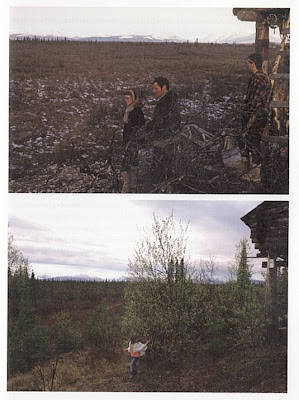 In Shopping for Porcupine: Life in Arctic Alaska, Seth Kantner brings to us the Alaska he knew growing up, and the Alaska of today. They are two very different Alaskas, neither of which is familiar to vacationers. Seth was born and raised, and lives today, ten or more miles north of the Arctic Circle. That means, for a few weeks each year, the Sun doesn't rise, though the southern horizon glows orange for an hour or two even on Midwinter's Day. He calls those days Darkness, with a capital D. Sometimes, when it is hard to sleep around Midsummer's, when the Sun doesn't set, he longs for a bit of Darkness.
In Shopping for Porcupine: Life in Arctic Alaska, Seth Kantner brings to us the Alaska he knew growing up, and the Alaska of today. They are two very different Alaskas, neither of which is familiar to vacationers. Seth was born and raised, and lives today, ten or more miles north of the Arctic Circle. That means, for a few weeks each year, the Sun doesn't rise, though the southern horizon glows orange for an hour or two even on Midwinter's Day. He calls those days Darkness, with a capital D. Sometimes, when it is hard to sleep around Midsummer's, when the Sun doesn't set, he longs for a bit of Darkness.I thought at first that, Porcupine being the name of an Alaskan town, he'd be writing about provisioning his home there. But that town is never mentioned. Anyway, it is way, way too far south, being near Glacier Bay. No, he means "shopping" as in "hunting". Porcupines are good eating, and so slow that you don't waste a bullet on one, you just club it. But this comes later in the book.
 The mainstay of people in the far north, those who live away from the sea, is the Caribou. When caribou aren't plentiful, for a few months in Winter, salmon and other fish one has netted and frozen away in early fall will tide over a family and their dogs. But caribou are the cattle of the northland. They thrive in conditions that are fatal to bovines. No wonder the Lapps "ranch" caribou, though they are called Reindeer in Lapland.
The mainstay of people in the far north, those who live away from the sea, is the Caribou. When caribou aren't plentiful, for a few months in Winter, salmon and other fish one has netted and frozen away in early fall will tide over a family and their dogs. But caribou are the cattle of the northland. They thrive in conditions that are fatal to bovines. No wonder the Lapps "ranch" caribou, though they are called Reindeer in Lapland.The book is filled with lore and landscapes. The author doesn't just love this mostly frozen land, he can't imagine living elsewhere. Now that he is a celebrated author, he has had to endure a few days here and there in places like Minneapolis or New York City. As he told a cabbie in New York, who said of Alaska, "I couldn't live like that," "People get used to different things."
And that is just the trouble. You get used to it, then it goes away. A full third of the chapters recount the ways Alaska has changed. There simply isn't a Subsistence way of life any more. The Eskimos, and those like Kantner who chose to live similarly, find it too easy to buy cotton-fleece-lined nylon windbreakers rather than sew a coat of animal hides with a wolverine ruff, though they need at least part-time jobs now, where before they didn't . The dogs are few, being replaced by snowmobiles, though some of the sleds they pull are still handmade.
 The land itself is changing. Whether "global warming" is humanity's fault of not, it is a fact. The upper panel of this image was taken in 1965, by the author's mother. The lower panel in 2007, from nearly the same viewpoint, shows that warmer conditions allow shrubs and trees to grow tall, that were limited to a few inches before. In some places, the melting permafrost makes the land melt right out from under you.
The land itself is changing. Whether "global warming" is humanity's fault of not, it is a fact. The upper panel of this image was taken in 1965, by the author's mother. The lower panel in 2007, from nearly the same viewpoint, shows that warmer conditions allow shrubs and trees to grow tall, that were limited to a few inches before. In some places, the melting permafrost makes the land melt right out from under you.The boy who grew up learning to drive dogs by age ten, helping catch the fish for overwintering, hunting almost everything that moved, living in a sod igloo (the ice ones are temporary shelters), and getting used to the nearest neighbors being miles away, now must work part time to buy things that replace what the land no longer yields, carries a cell phone (at least part of the time), and has learned to cope with his occasional visits to the Lower 48.
One who would seduce readers to dwell in his culture, at least in imagination, bears a heavy burden. Such a one must dwell enough in both worlds to know how to communicate with those who begin without the concepts to understand. Seth Kantner is just such a skilled translator, so that those of us who think sleety rain makes a cold day, can taste, just a bit, the land he loves best.



No comments:
Post a Comment